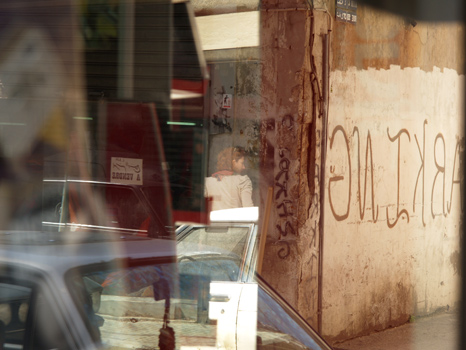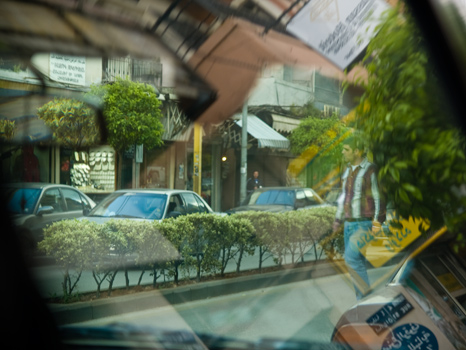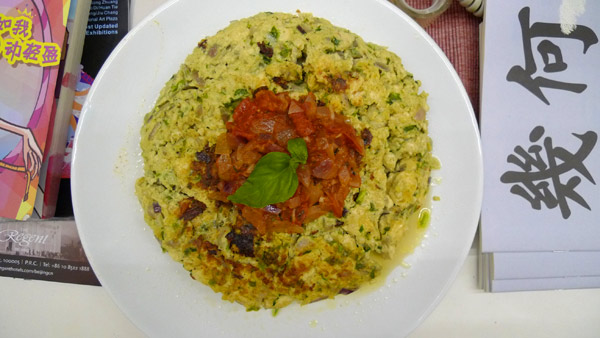It all started with an image, though one that really came into a so to speak light before it even existed. One sees, firstly. Punctum as a form or attention, filter or framing device——an interruption in the act of seeing which triggers a refraction where association is the flipping upside-down of the mirror as much as a natural stream of thought. Oh. Constantly grasping at words. Try to describe flows, try to pick up words that describe people: 散文诗人, the great essayist, experimental folk maker. One is never enough, of course——artist, writer, activist——but if i could describe to you a process instead then perhaps i wouldn’t have gone through it all in quite the same way anyway. Words destroy me, time passes, and in the meanwhile we play a few games.
It all started with a seasick steadicam. It was the bane of those first few weeks of working, becoming one of those challenges that one cannot give up on simply because you’ve already wasted too much time trying and cannot bear to let go in vain. And those many hours spent walking back and forth the third floor flat tinkering with an orange handsaw arm, PET bottle caps and various metal washers came out of a whim, really, based upon a beginner’s rereading of The Politics of Disappearance and moving around in Hong Kong. Movement, restlessness, sitting at a desk overlooking noisy Shanghai Street looking for the right troubleshooting video to make the damned steadicam work as it should. Sitting as restless as distraction, the wrong videos lead to other flows, like centripetally-spinning eggs scrambled inside the shell and shanzhai effecting tilt-shift optics with video and image-editing software.
And we continue to work within that distraction, as if the Cantonese version of looking (眱) already directed our eyes askance, the Scheimpflug principle was made physical as if we were moving throughout the city while laying down. Or seeing through a viewfinder, especially when mounted on a seasick steadicam held at waist-height. Tilt-shift is a subtle change in perspective, and your weak limb makes everything feel more distant, passive but with uncertain intention like sleeping next to someone with their back turned to you. I wonder if feeling distance from these images makes one more of a subject or less of one.
He says, “I am thinking. What if the body were not important?”
We keep walking along an overpass, and she comes to match our pace on my right, listening. She interrupts him at one point, and when she closes her statement with, “Maybe it’s an over-interpretation“, her body moves away from us while keeping the tempo.
Later while they are opening up the furled black banner in her arms, I say to him, “In principle, we should be free. But with the body there is possession. And with possession there is the basis for all socio-political conflict.” We stop at an intersection, in the middle of the street. Some people sit down.
It could have all started from there. He had warned me about getting arrested, but for all the supposed escalation it starts raining and traffic is restored. Everyone shoots images of everyone else. The three-man police film crew make a tilt-shift view, their camera perched on a gaffer pole above the crowd, one with his hands following gently on the shoulders of the gaffer. Everyone is in close proximity; the third is close behind.
She writes, for instance, “the Polis, properly speaking, is not the city-state in its physical location; it is the organization of the people as it arises out of acting and speaking together, and its true space lies between people living together for this purpose, no matter where they happen to be.†The “true†space then lies “between the people†which means that as much as any action takes place somewhere located, it also establishes a space which belongs properly to alliance itself.
—Judith Butler, “Bodies in Alliance and the Politics of the Street“
When you look up tilt-shift photography on Wikipedia, you will find an image of Hong Kong viewed from Victoria Peak, as if that particular perspective and reference were made for that kind of displacement; distortions require further tweaking before we realise that the spaces of camaraderie encompass kilometers and the ones around them hone in the millimeters of a lens during public conflict. Focus shifts while waiting in civic procession: a boring walk, intermittent conversation, a hand-painted sign. She asks how we can change the circumstances. It is uncertain whether or not the question is real, let alone try to imagine jouissance or our own semblance. Keep on walking, they say, there’s nothing to see here.
Posted by 丫 | reply »preliminary notes on ice house street

#今天å¦äº†ä»€ä¹ˆ# Realising today that we’re only speaking in colours, collaborations “no bad, only un-good”——meaning we work hard to reserve judgement, critique, oh, inauthentic observer, otherwise catty once becoming “a life-long association that would change the world”.
At the end of August, 1844, Engels passed through Paris, en route to his employment in Manchester, England, from visiting his family in Barmen (Germany). During 10 days in the French capital, he met Marx (for the second time).
Collaboration means meeting on occasion, sometimes intensively, we laugh at the easy jetset, asking lots of questions in diversion, desiring of the “tranquility of knowledge”. But that wasn’t it. This is non-knowledge, collaboration in colour, yes, Anastas/Gabri, Bester/Kishop or WoofShop, comparative studies as variations on a what, what you want, define and argue, get lost searching for the sea, in Elements, continue softer, what you want.
Would the ‘urban entropic conclusion’ require a certain withdrawal from the social, identity radii, we’re not obligated, her islands, come out only for exposure and/or discomfort. Rearrange the flat, morning study sessions, a cheap coffee maker and a broken electric stove. But it wasn’t really broken. Engage out of what you know, engage to counter what you know; they look similar, maybe, but stylistically…approach, a rationing, an investigation. What is continuity, in the end (har har har), but the careful arrangement of objects and the nice surprise that he even noticed?
Posted by 丫 | more »What can a phrase such as ‘natural course’ mean anymore in a time of such intense production?


At one point during one of our discussions, Jad mentioned something about the need to build systems and structures so that we can break free from them. At the time i did not agree so much, perhaps out of mere exhaustion (the dialectic), and maybe also there has just always been some part of me that desires to find out how far we can just let things go, or to understand the limits of tolerance.
Phasing works in a similar way, though taking a walk in the city makes a clean set of variables into a dirty game. The phase is an easy, fun experiment; it breaks out of itself predictably but still fascinating to listen to — self-contained by reception. But it seems difficult to consider any form of reality anymore in terms of such structure; what is always lies next to and around itself, everything is multiple. Perhaps it’s simply a poor understanding of mathematics, but I never know how to discern exponentiality from noise. Circling now (the dialectic), it’s another form of fascination — like listening to sound upon sound. Or maybe it’s simply the idea of being attentive to the things that have always been there.
This is an audio recording combining several journeys traced from an original route shared by Maral Der Boghossian, who has visited her father’s shop in Bourj Hammoud two to three times a week for over 25 years. At the time of this writing, not a single participant after Maral has been able to successfully follow the audio to reach the shop, and this reveals certain weaknesses in the structure of the game, but I guess it’s also just letting things follow their natural course.
//
Participants in the recording: Maral Der Boghossian, Jad Baaklini, Paul Gorra, George Haddad, Christophe Katrib (accidentally powered off), Céline Khairallah, Lynn Kodeih, Fotini Lazaridou-Hatzigoga, Lina Sahab and the blacksmith around the corner from the tree that Maral’s grandmother planted some 40 years ago.

April 2011, Beirut
Posted by 丫 | more »å±•è§ˆé¢˜ä¸ºâ€œå¦‚何独处†The Title of the Show is ‘How to Be Alone’
1// 《但愿我能为您æ绘得更好》第二期里献给å‹åçš„æŒ: “èœå•ï¼é‚£ä¹ˆä»Šå¤œä½•å¤„是京都ï¼çŒ«å’ªé©¬ç³â€ï¼ˆæ¼”唱者:“声音å‘导â€ä¹é˜Ÿï¼Œå£°éŸ³ä»‹å…¥éƒ¨åˆ†ï¼šä½•é¢–é›…ã€ä½•äº¬è•´ï¼‰ From the publication iwishicoulddescribeittoyoubetter number two, for Tomoko: “Menu/So Where Is Kyoto Tonight?/Mullin The Mog” by DirectorSound with inserts by Elaine W. HO and Anouchka van DRIEL
2// “解手与生产â€ï¼Œå°è¯•ä¸ºé«˜çµå£å¤´ç¿»è¯‘Paul CHAN的文本 “Pee and Productionâ€, trying to orally translate a text by Paul CHAN to GAO Ling
3// 爸爸骑ç€æ‘©æ‰˜ï¼Œ å„¿åå在åŽåº§ä¸Šæ‰“ç€å¿«æ¿ï¼Œ 我们一起在儿童电影夜场å–了点酒,家作åŠ2010å¹´Â The boy comes home with his father playing kuaiban, we had been drinking at the kids’ movie night, HomeShop 2010
4// “ä½ å¥½å‘€ï¼ŒåŠ³ä¼¦æ–¯è€å¸ˆï¼” 这段对我外婆的采访录音是1991年我ä¸å¦åŽ†å²è¯¾ä¸Šçš„家åºä½œä¸šâ€”—“å£è¿°åŽ†å²â€ï¼Œæˆ‘妈妈也在“其间â€ã€‚ “Hellll-o Mizz Lawrence!” An oral history project, my grandmother, mother and me, 1991
5// 五å²çš„我,在数数和唱æŒÂ When I was 5 years old, counting and singing
6// 我在è´ä¹°çš„è¿·ä½ SDå¡ä¸Šæ‰¾åˆ°äº†70多首æŒï¼Œä»Žä¸é€‰äº†å首æŒå¹¶é€šè¿‡æ•°ç 处ç†ï¼ŒæŠŠå®ƒä»¬çš„节æ‹ç»Ÿä¸€æˆæ¯åˆ†é’Ÿ120æ‹ï¼ˆç‰¹æ®Šæ„Ÿè°¢Ryan KING在数ç 处ç†ï¼‰ Music found on the micro-SD cards purchased to create this work, whereby among 70 songs in total ten were chosen and digitally synced at 120 beats per minute (processing courtesy of Ryan KING)
—–
装置在《第三房:如何独处》展览,站å°ä¸å›½ï¼Œ2010å¹´11月11æ—¥ï¼2011å¹´1月24æ—¥
Installation part of The Third Party: How to Be Alone (or nowhere else am i safe from the question: why here?), on view at Platform China, 11 November 2010 – 24 January 2011
THE WORK (for 絵美 and a friend of hers, and for everyone amidst iwishicoulddescribeittoyoubetter)
How could this be institutionalised? In describing, putting the words to entities, in finding vocabularies and knowing where to look, we are trapped already. How couldn’t we be? Should I write such that you never understand; should I make work that never needs to be seen; should anything other than question marks arise?
Is this a work? Would we rather toss it all off to a little game, scoff at those who take themselves too seriously, never be so ridiculous as to consider the nests of “art” and “life”? Are the words one is using as important as the to whom one is speaking? “What is the work of man?” And why not say it, invest oneself with intention, make the attempt? Flail? This is not an institution, as could it ever be, with time, with the fulfillment of certain criteria of Work. We are tied to a production as always, since before we were aware of it, since we were animals. And the guillotined bumblebee, as Agamben asks, is he as busy as ever, do we continue amidst work, does time fly when…?
Should anything other than question marks arise?
What-is-the-work?
Should the work be defined by a trade, a certain amount of craftsmanship, the ergon of man, a list of projects and venues to which one must be flown? Does work define our activities or does activity define work? Why should vita contemplativa be placed above vita activa in a society with no God? Is this the captivation of the bumblebee, are we productive enough, should we make particular dialogues in work-group fashion? Because if I play, or if i dangerously mix words like “art” and “life”, like you know, when
Every afternoon he goes there to see a big painting for two hours, and he says, ‘I’m doing the work to see the work’. That’s ok, I think it’s no problem. He did another work where he pays for three months of traditional Chinese music lessons, on the erhu. – 马永峰 MA Yongfeng, Forget Art
Can a situation be Work? Our particular arrangement to one another, did you try that out, were you networking? Is the amount of control in any given situation a Work? Is control a result of the fact that there is no one around to help us, or that we are ‘mere’ fascists? Is the controlled situation a place of God or science or politics? Why do you question, why go beyond captivation? What did you question, what did you create, where did you control the situation and where was spontaneity a lie? 艾未未 AI Weiwei calls it the “vocabulary” that “can also be the total meaning of the concept”; Pierre Huyghe says a one:to:one ratio of idea:to:form. These are control experiments, perhaps, but not without the certain seepages that blur the distances between the Work and our ethics, our politics——our everyday. We take ourselves too seriously. In the fullness of the situation, yes. And yes, he is right, we could not presume it to be so before its occurrence, where there is thus the very small moment when the lack of control has perchance to touch upon the work’s going beyond itself. An eventfullness…
Have we said too much already? Really, should anything other than question marks arise?
Are these thinly veiled treatises, and what have you really got to say?
Stopping oneself… (slow, slow loading, please be patient)
Posted by 丫 | more »chainletter dinner
We prepared some of your recipes…
Maria Kley:

何京蕴 Anouchka van Driel & Jasmina van Driel:

Please click “more” below to see the full recipes.
Posted by secretary | more »ã¾ãŸã‚„ã‚Šã¾ã™ã€ã‹ã£ã½ã†ç€å±•ï¼
京都ã®ä¸‰æ¡å•†åº—è¡—ã®TOTTEã•ã‚“ã§ã€Œã‹ã£ã½ã†ç€å±•ã€ã‚’開催ã—ã¾ã™ã€‚
昨年ã®GWä¸ã«ã“ã“ã§é–‹å‚¬ã—ãŸã€åˆã‚ã¦ã®ã€Œã‹ã£ã½ã†ç€å±•ã€ãŒã€æ—¥ã€…èšã®æ´»å‹•ã®ãã£ã‹ã‘を作ã£ã¦ãã‚ŒãŸã¨ã„ã£ã¦ã‚‚éŽè¨€ã§ã¯ã‚ã‚Šã¾ã›ã‚“。
TOTTEã•ã‚“ã¯ã€ç„¼ãè“åã‚’ä¸å¿ƒã¨ã—ãŸç¾Žå‘³ã—ã„ãŠã‚„ã¤ã¨ã€åº—主セレクトã®é£Ÿå“や雑貨を扱ã†ãŠåº—ã§ã™ã€‚å°ã•ãªã‚«ãƒ•ã‚§ã‚¹ãƒšãƒ¼ã‚¹ã‚‚ã‚ã‚‹ã®ã§ã€ã»ã£ã“ã‚Šã—ã¦ã„㟠ã ã‘ã¾ã™ã€‚最近ã€è‰²ã€…æ–°ã—ã„ãŠåº—も増ãˆã¦ã€ç››ã‚Šä¸ŠãŒã‚Šã‚’見ã›ã¦ã„る三æ¡å•†åº—è¡—ã€ã¶ã‚‰ã¶ã‚‰ãŠæ•£æ©ãŒã¦ã‚‰ã€ãŠã“ã—ãã ã•ã„。
日々èšhibitan ã‹ã£ã½ã†ç€å±•
〜ç€ãªããªã£ãŸã‚·ãƒ£ãƒ„ã‹ã‚‰ä½œã£ãŸæš®ã‚‰ã—ã®è¡£æœã€œ
◆日時 2010年3月1日(月)〜7日(日)
12:00〜20:00(最終日ã¯18:00ã¾ã§ï¼‰
*1ã€ï¼“ã€ï¼–ã€ï¼—æ—¥14:00〜 作り手ãŒä¼šå ´ã«å±…ã¾ã™ï¼ˆã‚ªãƒ¼ãƒ€ãƒ¼ã‚‚ã“ã®
æ—¥ã«å—ã‘付ã‘ã¾ã™ï¼‰

â—†ä¼šå ´ã€€TOTTE京都市ä¸äº¬åŒºä¸‰æ¡çŒªç†Šè¥¿å…¥ã‚‹
tel 075−801−0550  営æ¥æ™‚間:月〜金12:00〜20:00
土日休(会期ä¸ã¯å–¶æ¥ï¼‰
ï¼Šä¼šå ´ã«ç€ãªããªã£ãŸã‚·ãƒ£ãƒ„やブラウスをãŠæŒã¡ãã ã•ã„。シミやã‚ズãŒã‚ã£ã¦ã‚‚ã‹ã¾ã„ã¾ã›ã‚“ãŒã€æ´—濯ã—ãŸç‰©ã‚’ãŠé¡˜ã„ã—ã¾ã™ã€‚引ãæ›ãˆã«ã•ã•ã‚„ã‹ãªãŠç¤¼ã‚’ã•ã—ã‚ã’ã¾ã™ã€‚
Posted by anyway | reply »acci-cocciオープン

オランダ留å¦æ™‚代ã«å‡ºä¼šã„ã€ç¾åœ°ã§ä¸€ç·’ã«æš®ã‚‰ã—ãŸã“ã¨ã‚‚ã‚ã‚‹å‹äººã€å®®æ²¢ã•ãŠã‚Šã•ã‚“ãŒã€æ˜¨å¹´ã‹ã‚‰å®¶æ—ã¨ä¸€ç·’ã«ä½æ¸¡å³¶ã«ä½ã‚“ã§ã„ã¾ã™ã€‚ãã®å½¼å¥³ãŒãƒ™ãƒ«ã‚®ãƒ¼äººã®ãƒ‘ートナーã€ã‚¢ãƒ«ãƒŽ ムールマンã¨å…±ã«acci-cocciã¨ã„ã†ã‚¹ãƒšãƒ¼ã‚¹ã‚’1月16æ—¥ã«ã‚ªãƒ¼ãƒ—ンã—ã¾ã—ãŸã€‚
ã‚‚ã¨ã‚‚ã¨èº«ä½“表ç¾ã‚’å°‚é–€ã¨ã™ã‚‹å½¼å¥³ã¨ã€ç©ºé–“ã‚„æ˜ åƒã‚’扱ã†ã‚¢ãƒ¼ãƒ†ã‚£ã‚¹ãƒˆã§ã‚ã‚‹å½¼ã¯ã€ãƒ–リュッセル→倉敷→ä½æ¸¡å³¶ã¨ç§»å‹•ã—ãªãŒã‚‰ã€æ§˜ã€…ãªã‚³ãƒ©ãƒœãƒ¬ãƒ¼ã‚·ãƒ§ãƒ³ã‚’ è¡Œã£ã¦ãã¾ã—ãŸã€‚acci-cocciã¯ã€ï¼’人ã®å®Ÿé¨“ã®å ´ã§ã‚ã‚‹ã¨åŒæ™‚ã«ã€ã‚ã£ã¡ã“ã£ã¡ã‚’繋ã’ã¦ç™ºä¿¡ã™ã‚‹é¢ç™½ã„å ´æ‰€ã«ãªã‚Šãã†ã§ã™ã€‚
ãã‚“ãªacci-cocciã®ã‚ªãƒ¼ãƒ—ンã®ãŠç¥ã„ã«é§†ã‘ã¤ã‘ãŸã„ã¨ã“ã‚ã§ã—ãŸãŒã€æ®‹å¿µãªãŒã‚‰å¶ã‚ãªã„ã®ã§ã€ã‚ªãƒ¼ãƒ—ニングã§ãƒ™ãƒ«ã‚®ãƒ¼ãƒ¯ãƒƒãƒ•ãƒ«ã‚’焼ãã¨ã„ã†ã‚¢ãƒ«ãƒŽã«ã€ã‹ã£ã½ã†ç€ã‚’贈りã¾ã—ãŸã€‚ãªã‹ãªã‹æ§˜ã«ãªã£ã¦ã„ã¾ã™ï¼
ã§ãã‚Œã°ã€2010å¹´ä¸ã«ã€Œã‹ã£ã½ã†ç€å±• in ä½æ¸¡ã€ã‚’å¶ãˆãŸã„ã¨æ€ã„ã¾ã™ã€‚
ã¡ãªã¿ã«ã€ãƒ¨ã‚¬ã®è¬›å¸«ã‚‚ã¤ã¨ã‚ã‚‹å‹äººã¯ã‚¹ãƒšãƒ¼ã‚¹ã®éš£ã®ã‚ªãƒ¼ã‚·ãƒ£ãƒ³ãƒ“ュー(ï¼ï¼‰ã®éƒ¨å±‹ã§ãƒ¨ã‚¬æ•™å®¤ã‚’ã‚„ã£ã¦ã„ã¾ã™ã€‚今年ã®ä½æ¸¡è¡Œãã®å¤¢ãŒå¶ã£ãŸã‚‰ã€ãã¡ã‚‰ã«ã‚‚是éžå‚åŠ ã—ã¦ã¿ãŸã„ã¨æ€ã£ã¦ã„ã¾ã™ã€‚
– cross-posted from hibi_tan | 2010-01-19 00:12
Posted by anyway | reply »





